Health Care Policies: Community-Based Support and User Pay Systems
VerifiedAdded on 2022/09/15
|7
|1955
|12
Report
AI Summary
This report analyzes various aspects of health care policies, focusing on community-based support services (CBSS), person-centered care, and the user pays system within the context of aged care. CBSS aims to facilitate safe community living for seniors, delaying institutionalization by providing support like nutritional programs and counseling. The report emphasizes the person-centered care model, which prioritizes the needs and preferences of older adults, promoting their independence and involvement in decision-making. It also examines the user pays system in Australia, highlighting the shift from government-funded services and the implications of this system, including ethical and political considerations, and the potential impact on the quality of care and access to services. The report references several studies and articles to support its analysis, offering insights into the complexities of aged care policies.

Running head: HEALTH CARE POLICIES
HEALTH CARE POLICIES
Name of the Student
Name of the University
Author note
HEALTH CARE POLICIES
Name of the Student
Name of the University
Author note
Paraphrase This Document
Need a fresh take? Get an instant paraphrase of this document with our AI Paraphraser
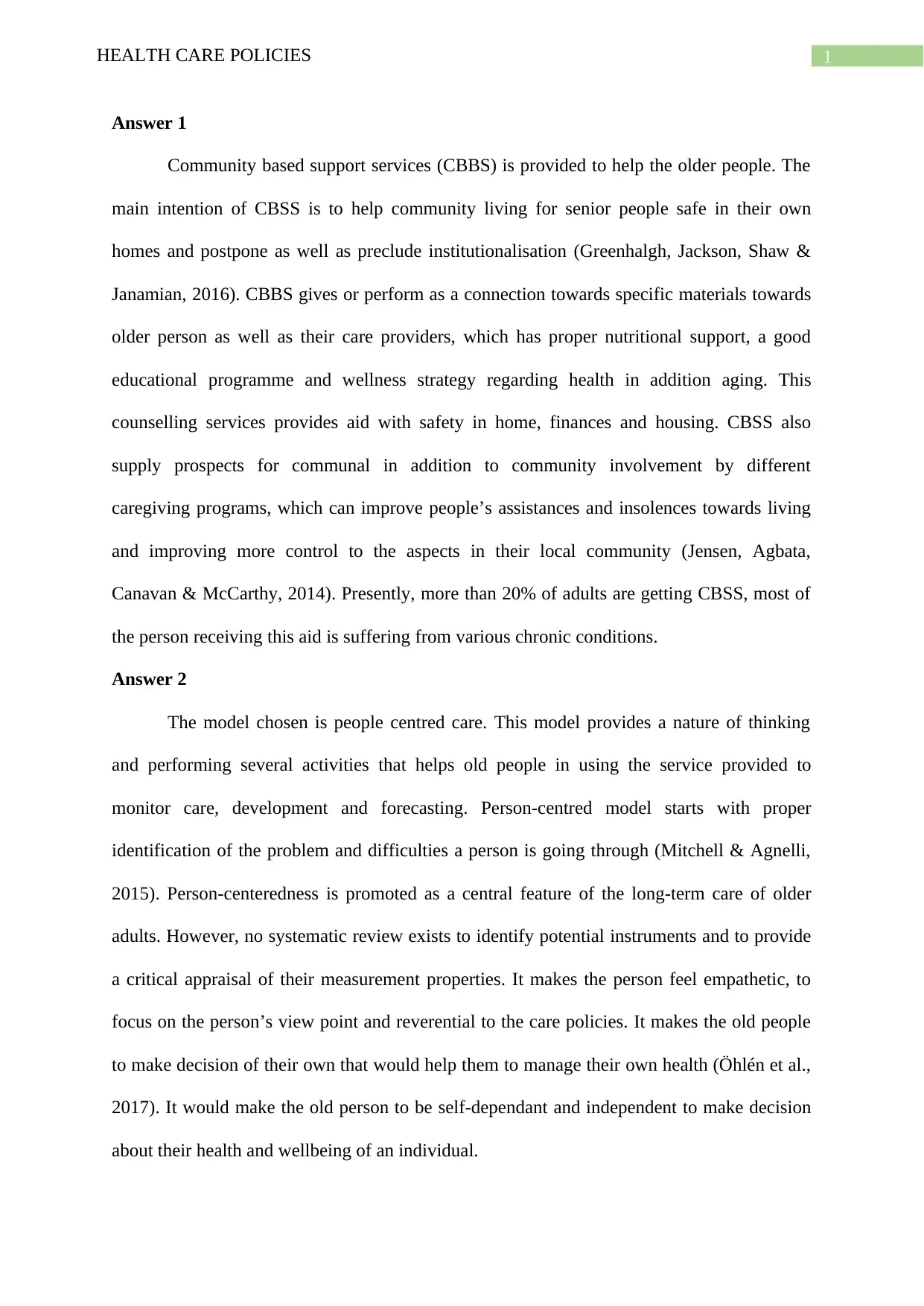
1HEALTH CARE POLICIES
Answer 1
Community based support services (CBBS) is provided to help the older people. The
main intention of CBSS is to help community living for senior people safe in their own
homes and postpone as well as preclude institutionalisation (Greenhalgh, Jackson, Shaw &
Janamian, 2016). CBBS gives or perform as a connection towards specific materials towards
older person as well as their care providers, which has proper nutritional support, a good
educational programme and wellness strategy regarding health in addition aging. This
counselling services provides aid with safety in home, finances and housing. CBSS also
supply prospects for communal in addition to community involvement by different
caregiving programs, which can improve people’s assistances and insolences towards living
and improving more control to the aspects in their local community (Jensen, Agbata,
Canavan & McCarthy, 2014). Presently, more than 20% of adults are getting CBSS, most of
the person receiving this aid is suffering from various chronic conditions.
Answer 2
The model chosen is people centred care. This model provides a nature of thinking
and performing several activities that helps old people in using the service provided to
monitor care, development and forecasting. Person-centred model starts with proper
identification of the problem and difficulties a person is going through (Mitchell & Agnelli,
2015). Person-centeredness is promoted as a central feature of the long-term care of older
adults. However, no systematic review exists to identify potential instruments and to provide
a critical appraisal of their measurement properties. It makes the person feel empathetic, to
focus on the person’s view point and reverential to the care policies. It makes the old people
to make decision of their own that would help them to manage their own health (Öhlén et al.,
2017). It would make the old person to be self-dependant and independent to make decision
about their health and wellbeing of an individual.
Answer 1
Community based support services (CBBS) is provided to help the older people. The
main intention of CBSS is to help community living for senior people safe in their own
homes and postpone as well as preclude institutionalisation (Greenhalgh, Jackson, Shaw &
Janamian, 2016). CBBS gives or perform as a connection towards specific materials towards
older person as well as their care providers, which has proper nutritional support, a good
educational programme and wellness strategy regarding health in addition aging. This
counselling services provides aid with safety in home, finances and housing. CBSS also
supply prospects for communal in addition to community involvement by different
caregiving programs, which can improve people’s assistances and insolences towards living
and improving more control to the aspects in their local community (Jensen, Agbata,
Canavan & McCarthy, 2014). Presently, more than 20% of adults are getting CBSS, most of
the person receiving this aid is suffering from various chronic conditions.
Answer 2
The model chosen is people centred care. This model provides a nature of thinking
and performing several activities that helps old people in using the service provided to
monitor care, development and forecasting. Person-centred model starts with proper
identification of the problem and difficulties a person is going through (Mitchell & Agnelli,
2015). Person-centeredness is promoted as a central feature of the long-term care of older
adults. However, no systematic review exists to identify potential instruments and to provide
a critical appraisal of their measurement properties. It makes the person feel empathetic, to
focus on the person’s view point and reverential to the care policies. It makes the old people
to make decision of their own that would help them to manage their own health (Öhlén et al.,
2017). It would make the old person to be self-dependant and independent to make decision
about their health and wellbeing of an individual.
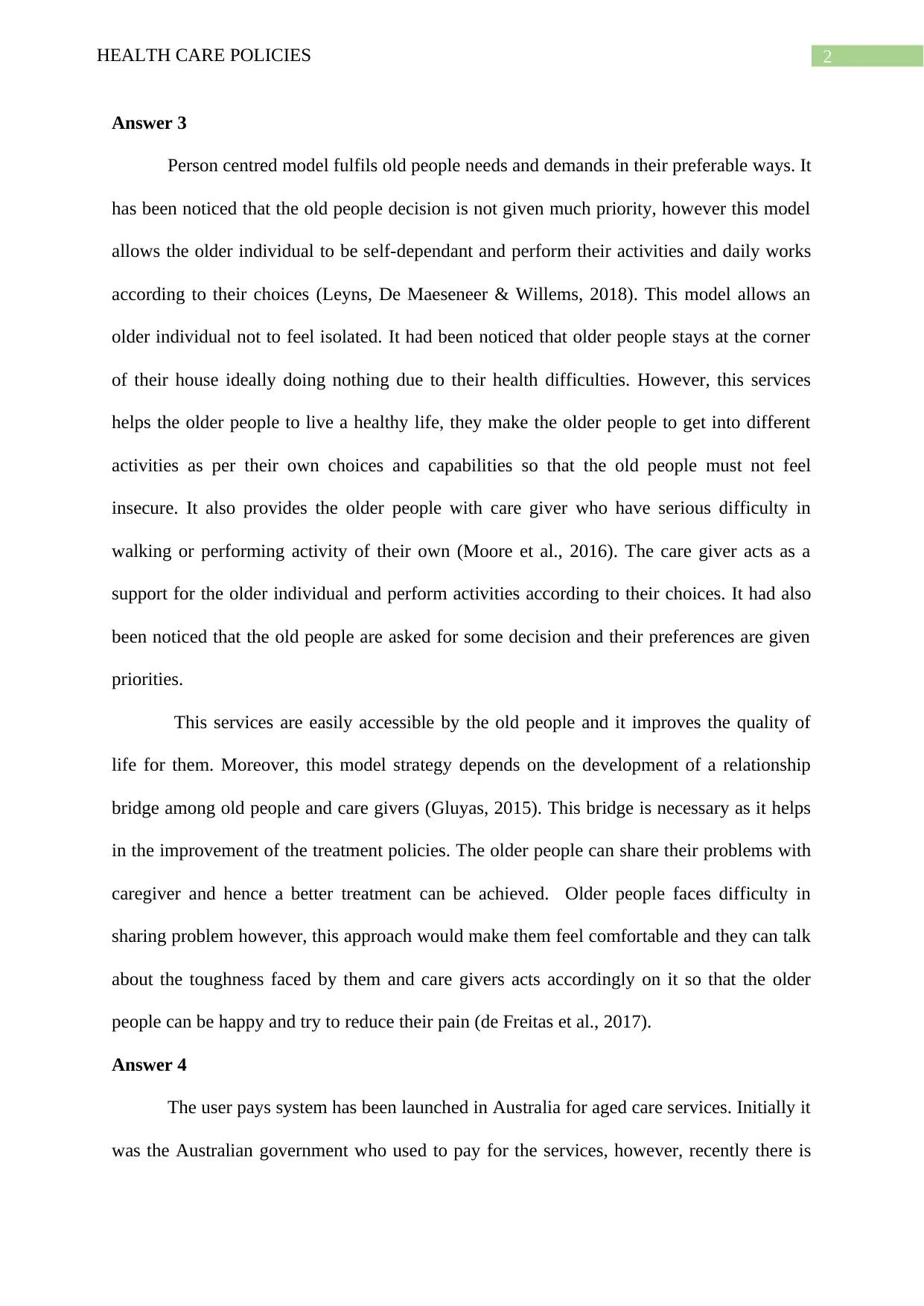
2HEALTH CARE POLICIES
Answer 3
Person centred model fulfils old people needs and demands in their preferable ways. It
has been noticed that the old people decision is not given much priority, however this model
allows the older individual to be self-dependant and perform their activities and daily works
according to their choices (Leyns, De Maeseneer & Willems, 2018). This model allows an
older individual not to feel isolated. It had been noticed that older people stays at the corner
of their house ideally doing nothing due to their health difficulties. However, this services
helps the older people to live a healthy life, they make the older people to get into different
activities as per their own choices and capabilities so that the old people must not feel
insecure. It also provides the older people with care giver who have serious difficulty in
walking or performing activity of their own (Moore et al., 2016). The care giver acts as a
support for the older individual and perform activities according to their choices. It had also
been noticed that the old people are asked for some decision and their preferences are given
priorities.
This services are easily accessible by the old people and it improves the quality of
life for them. Moreover, this model strategy depends on the development of a relationship
bridge among old people and care givers (Gluyas, 2015). This bridge is necessary as it helps
in the improvement of the treatment policies. The older people can share their problems with
caregiver and hence a better treatment can be achieved. Older people faces difficulty in
sharing problem however, this approach would make them feel comfortable and they can talk
about the toughness faced by them and care givers acts accordingly on it so that the older
people can be happy and try to reduce their pain (de Freitas et al., 2017).
Answer 4
The user pays system has been launched in Australia for aged care services. Initially it
was the Australian government who used to pay for the services, however, recently there is
Answer 3
Person centred model fulfils old people needs and demands in their preferable ways. It
has been noticed that the old people decision is not given much priority, however this model
allows the older individual to be self-dependant and perform their activities and daily works
according to their choices (Leyns, De Maeseneer & Willems, 2018). This model allows an
older individual not to feel isolated. It had been noticed that older people stays at the corner
of their house ideally doing nothing due to their health difficulties. However, this services
helps the older people to live a healthy life, they make the older people to get into different
activities as per their own choices and capabilities so that the old people must not feel
insecure. It also provides the older people with care giver who have serious difficulty in
walking or performing activity of their own (Moore et al., 2016). The care giver acts as a
support for the older individual and perform activities according to their choices. It had also
been noticed that the old people are asked for some decision and their preferences are given
priorities.
This services are easily accessible by the old people and it improves the quality of
life for them. Moreover, this model strategy depends on the development of a relationship
bridge among old people and care givers (Gluyas, 2015). This bridge is necessary as it helps
in the improvement of the treatment policies. The older people can share their problems with
caregiver and hence a better treatment can be achieved. Older people faces difficulty in
sharing problem however, this approach would make them feel comfortable and they can talk
about the toughness faced by them and care givers acts accordingly on it so that the older
people can be happy and try to reduce their pain (de Freitas et al., 2017).
Answer 4
The user pays system has been launched in Australia for aged care services. Initially it
was the Australian government who used to pay for the services, however, recently there is
⊘ This is a preview!⊘
Do you want full access?
Subscribe today to unlock all pages.

Trusted by 1+ million students worldwide

3HEALTH CARE POLICIES
tremendous growth in the health difficulties in the older individual that is increasing the cost.
Hence, government cannot pay for it in total. Therefore, there is implementation of the user
pays system (Bray, Straney, Barger & Finn, 2015). This system makes the old people to pay
for their care however the payment is done in instalments. There are many cases where it
becomes difficult for the older person to pay, hence there is different scheme for them. The
older person can ask for government help, in that it has been observed that government pays
the full caregiving of the older individual. The government pays significant amount for the
aged care homes so that older people do not find difficulty in surviving however recently this
system implemented.
Many times it had been noticed that that older people are asked to choose the kind of
service they want, as the government funded service is different than the self-paid service.
According, to this principal the old people are allowed to choose and accordingly service is
given (Heagney, Kovac, Fountain & Conner, 2015). User care system implantation showed
that the old individual can demand the kind of care and attention they want. As they are
paying by themselves the care system provided is better than the government funded care.
The amount the person has to pay also depends on the time they need the service and number
of care givers involved in the service. Moreover, it had also been noticed that the when a
person is paying for themselves there is a style of improper behaviour towards caregiver, they
behave rudely with care takers as they think that payment of money is done by the family
hence it becomes tough for care givers to provide proper service due to misbehaviour faced
by them.
Political issue faced by user care system is that government is not under pressure of
paying for each and every individual. Government can distribute the money and not spend on
a single unit. Even though the government is paying a partial amount there are many people
who raise question against the government for not paying full service (Gurran & Ruming,
tremendous growth in the health difficulties in the older individual that is increasing the cost.
Hence, government cannot pay for it in total. Therefore, there is implementation of the user
pays system (Bray, Straney, Barger & Finn, 2015). This system makes the old people to pay
for their care however the payment is done in instalments. There are many cases where it
becomes difficult for the older person to pay, hence there is different scheme for them. The
older person can ask for government help, in that it has been observed that government pays
the full caregiving of the older individual. The government pays significant amount for the
aged care homes so that older people do not find difficulty in surviving however recently this
system implemented.
Many times it had been noticed that that older people are asked to choose the kind of
service they want, as the government funded service is different than the self-paid service.
According, to this principal the old people are allowed to choose and accordingly service is
given (Heagney, Kovac, Fountain & Conner, 2015). User care system implantation showed
that the old individual can demand the kind of care and attention they want. As they are
paying by themselves the care system provided is better than the government funded care.
The amount the person has to pay also depends on the time they need the service and number
of care givers involved in the service. Moreover, it had also been noticed that the when a
person is paying for themselves there is a style of improper behaviour towards caregiver, they
behave rudely with care takers as they think that payment of money is done by the family
hence it becomes tough for care givers to provide proper service due to misbehaviour faced
by them.
Political issue faced by user care system is that government is not under pressure of
paying for each and every individual. Government can distribute the money and not spend on
a single unit. Even though the government is paying a partial amount there are many people
who raise question against the government for not paying full service (Gurran & Ruming,
Paraphrase This Document
Need a fresh take? Get an instant paraphrase of this document with our AI Paraphraser
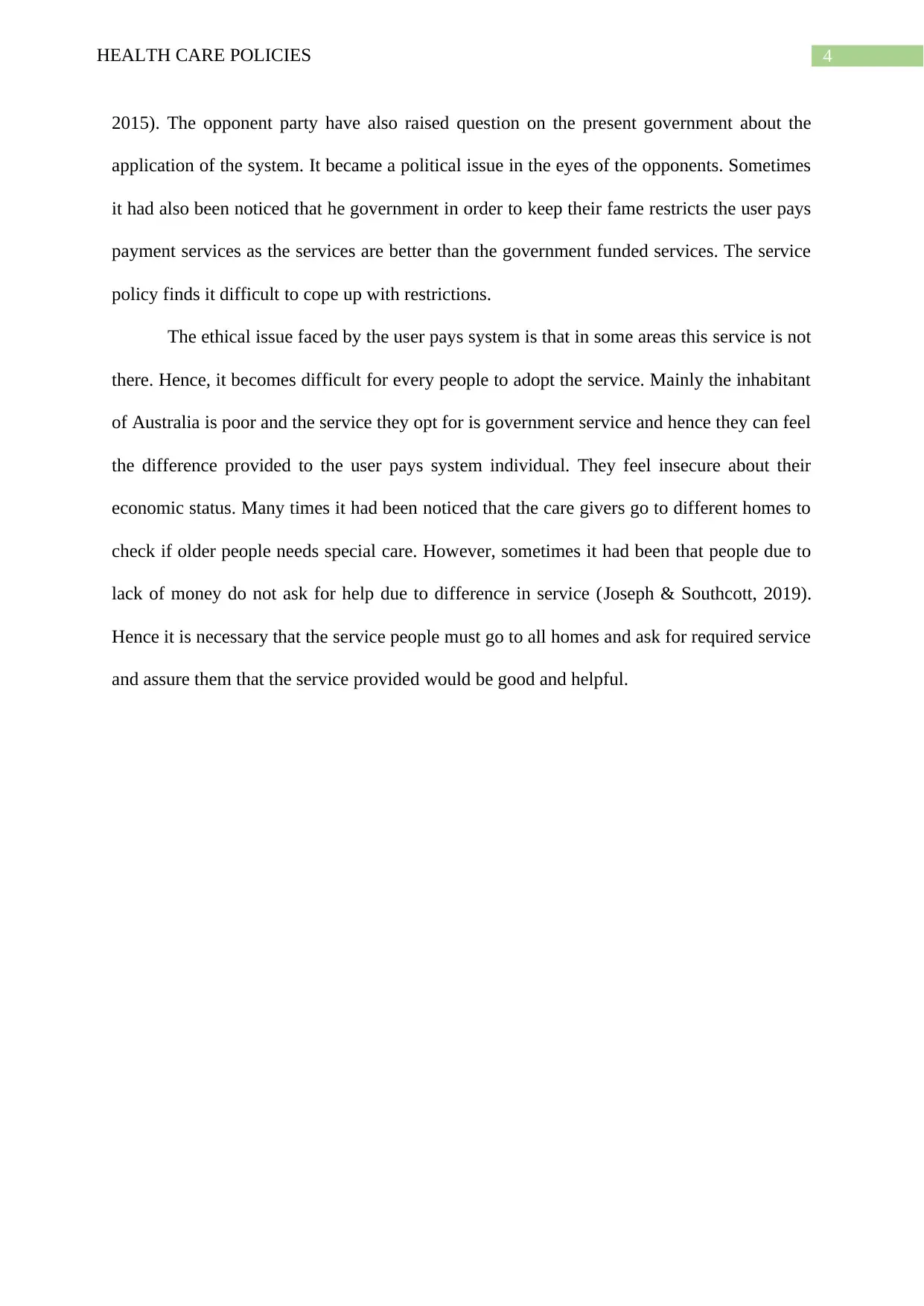
4HEALTH CARE POLICIES
2015). The opponent party have also raised question on the present government about the
application of the system. It became a political issue in the eyes of the opponents. Sometimes
it had also been noticed that he government in order to keep their fame restricts the user pays
payment services as the services are better than the government funded services. The service
policy finds it difficult to cope up with restrictions.
The ethical issue faced by the user pays system is that in some areas this service is not
there. Hence, it becomes difficult for every people to adopt the service. Mainly the inhabitant
of Australia is poor and the service they opt for is government service and hence they can feel
the difference provided to the user pays system individual. They feel insecure about their
economic status. Many times it had been noticed that the care givers go to different homes to
check if older people needs special care. However, sometimes it had been that people due to
lack of money do not ask for help due to difference in service (Joseph & Southcott, 2019).
Hence it is necessary that the service people must go to all homes and ask for required service
and assure them that the service provided would be good and helpful.
2015). The opponent party have also raised question on the present government about the
application of the system. It became a political issue in the eyes of the opponents. Sometimes
it had also been noticed that he government in order to keep their fame restricts the user pays
payment services as the services are better than the government funded services. The service
policy finds it difficult to cope up with restrictions.
The ethical issue faced by the user pays system is that in some areas this service is not
there. Hence, it becomes difficult for every people to adopt the service. Mainly the inhabitant
of Australia is poor and the service they opt for is government service and hence they can feel
the difference provided to the user pays system individual. They feel insecure about their
economic status. Many times it had been noticed that the care givers go to different homes to
check if older people needs special care. However, sometimes it had been that people due to
lack of money do not ask for help due to difference in service (Joseph & Southcott, 2019).
Hence it is necessary that the service people must go to all homes and ask for required service
and assure them that the service provided would be good and helpful.
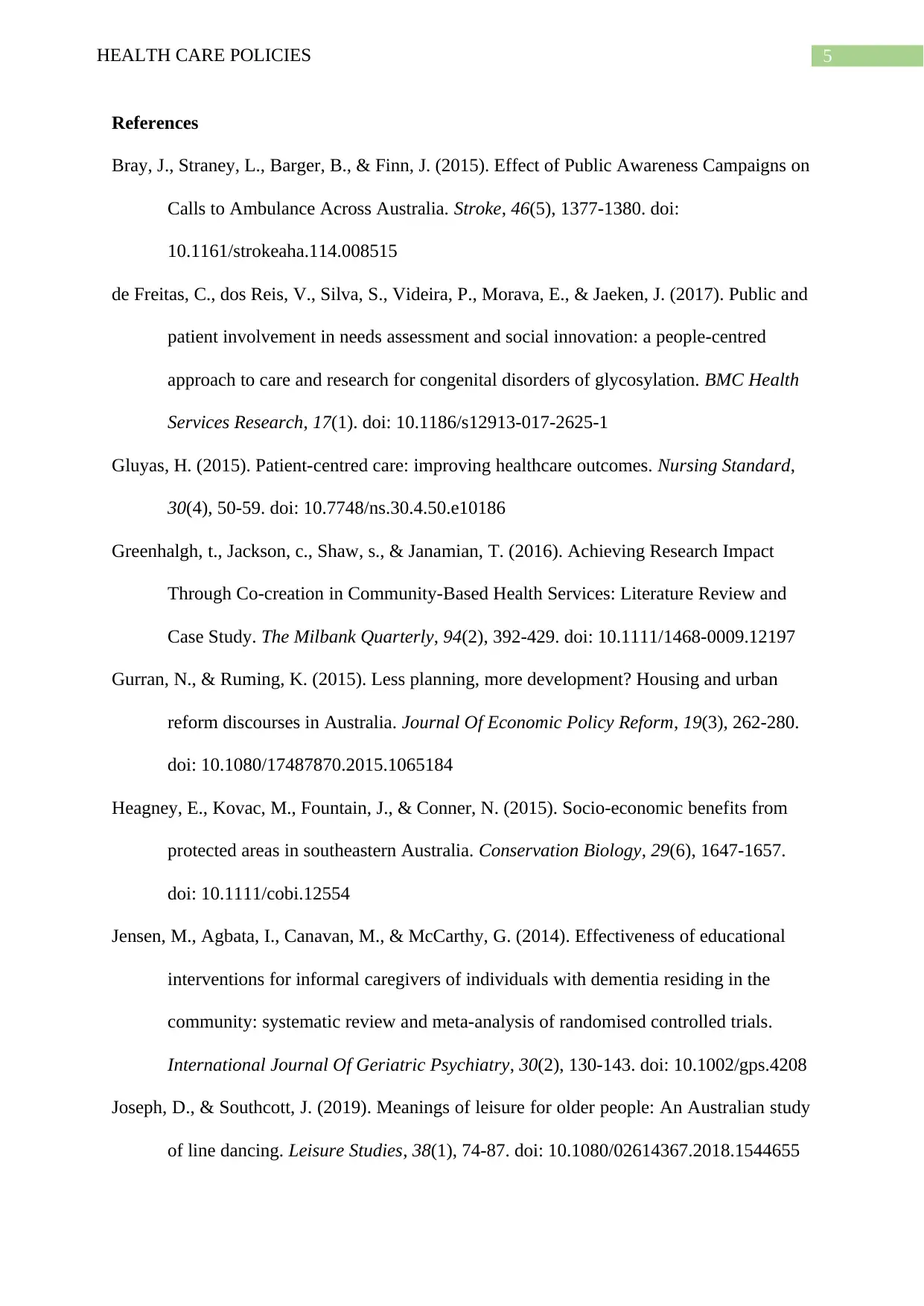
5HEALTH CARE POLICIES
References
Bray, J., Straney, L., Barger, B., & Finn, J. (2015). Effect of Public Awareness Campaigns on
Calls to Ambulance Across Australia. Stroke, 46(5), 1377-1380. doi:
10.1161/strokeaha.114.008515
de Freitas, C., dos Reis, V., Silva, S., Videira, P., Morava, E., & Jaeken, J. (2017). Public and
patient involvement in needs assessment and social innovation: a people-centred
approach to care and research for congenital disorders of glycosylation. BMC Health
Services Research, 17(1). doi: 10.1186/s12913-017-2625-1
Gluyas, H. (2015). Patient-centred care: improving healthcare outcomes. Nursing Standard,
30(4), 50-59. doi: 10.7748/ns.30.4.50.e10186
Greenhalgh, t., Jackson, c., Shaw, s., & Janamian, T. (2016). Achieving Research Impact
Through Co-creation in Community-Based Health Services: Literature Review and
Case Study. The Milbank Quarterly, 94(2), 392-429. doi: 10.1111/1468-0009.12197
Gurran, N., & Ruming, K. (2015). Less planning, more development? Housing and urban
reform discourses in Australia. Journal Of Economic Policy Reform, 19(3), 262-280.
doi: 10.1080/17487870.2015.1065184
Heagney, E., Kovac, M., Fountain, J., & Conner, N. (2015). Socio-economic benefits from
protected areas in southeastern Australia. Conservation Biology, 29(6), 1647-1657.
doi: 10.1111/cobi.12554
Jensen, M., Agbata, I., Canavan, M., & McCarthy, G. (2014). Effectiveness of educational
interventions for informal caregivers of individuals with dementia residing in the
community: systematic review and meta-analysis of randomised controlled trials.
International Journal Of Geriatric Psychiatry, 30(2), 130-143. doi: 10.1002/gps.4208
Joseph, D., & Southcott, J. (2019). Meanings of leisure for older people: An Australian study
of line dancing. Leisure Studies, 38(1), 74-87. doi: 10.1080/02614367.2018.1544655
References
Bray, J., Straney, L., Barger, B., & Finn, J. (2015). Effect of Public Awareness Campaigns on
Calls to Ambulance Across Australia. Stroke, 46(5), 1377-1380. doi:
10.1161/strokeaha.114.008515
de Freitas, C., dos Reis, V., Silva, S., Videira, P., Morava, E., & Jaeken, J. (2017). Public and
patient involvement in needs assessment and social innovation: a people-centred
approach to care and research for congenital disorders of glycosylation. BMC Health
Services Research, 17(1). doi: 10.1186/s12913-017-2625-1
Gluyas, H. (2015). Patient-centred care: improving healthcare outcomes. Nursing Standard,
30(4), 50-59. doi: 10.7748/ns.30.4.50.e10186
Greenhalgh, t., Jackson, c., Shaw, s., & Janamian, T. (2016). Achieving Research Impact
Through Co-creation in Community-Based Health Services: Literature Review and
Case Study. The Milbank Quarterly, 94(2), 392-429. doi: 10.1111/1468-0009.12197
Gurran, N., & Ruming, K. (2015). Less planning, more development? Housing and urban
reform discourses in Australia. Journal Of Economic Policy Reform, 19(3), 262-280.
doi: 10.1080/17487870.2015.1065184
Heagney, E., Kovac, M., Fountain, J., & Conner, N. (2015). Socio-economic benefits from
protected areas in southeastern Australia. Conservation Biology, 29(6), 1647-1657.
doi: 10.1111/cobi.12554
Jensen, M., Agbata, I., Canavan, M., & McCarthy, G. (2014). Effectiveness of educational
interventions for informal caregivers of individuals with dementia residing in the
community: systematic review and meta-analysis of randomised controlled trials.
International Journal Of Geriatric Psychiatry, 30(2), 130-143. doi: 10.1002/gps.4208
Joseph, D., & Southcott, J. (2019). Meanings of leisure for older people: An Australian study
of line dancing. Leisure Studies, 38(1), 74-87. doi: 10.1080/02614367.2018.1544655
⊘ This is a preview!⊘
Do you want full access?
Subscribe today to unlock all pages.

Trusted by 1+ million students worldwide
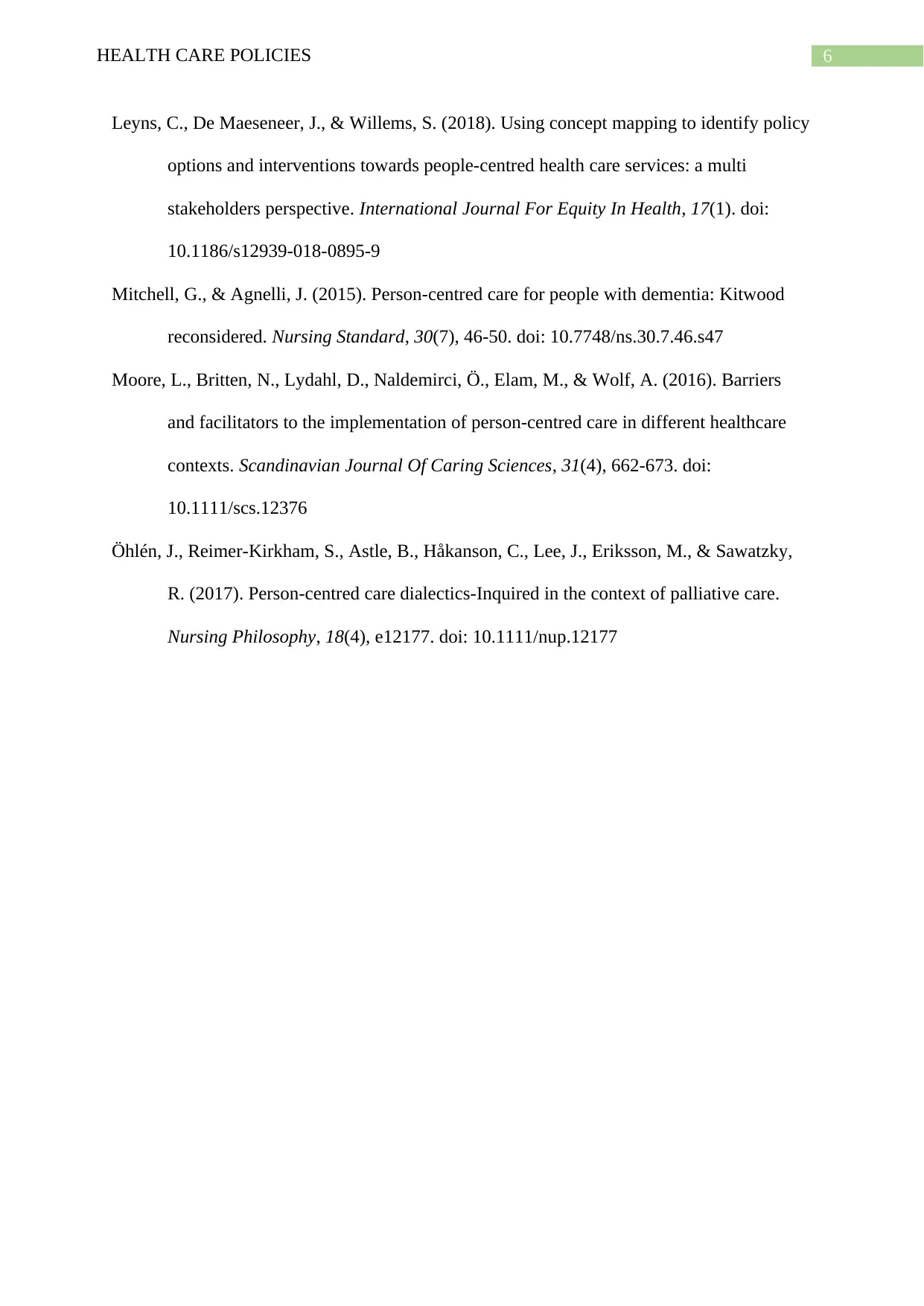
6HEALTH CARE POLICIES
Leyns, C., De Maeseneer, J., & Willems, S. (2018). Using concept mapping to identify policy
options and interventions towards people-centred health care services: a multi
stakeholders perspective. International Journal For Equity In Health, 17(1). doi:
10.1186/s12939-018-0895-9
Mitchell, G., & Agnelli, J. (2015). Person-centred care for people with dementia: Kitwood
reconsidered. Nursing Standard, 30(7), 46-50. doi: 10.7748/ns.30.7.46.s47
Moore, L., Britten, N., Lydahl, D., Naldemirci, Ö., Elam, M., & Wolf, A. (2016). Barriers
and facilitators to the implementation of person-centred care in different healthcare
contexts. Scandinavian Journal Of Caring Sciences, 31(4), 662-673. doi:
10.1111/scs.12376
Öhlén, J., Reimer-Kirkham, S., Astle, B., Håkanson, C., Lee, J., Eriksson, M., & Sawatzky,
R. (2017). Person-centred care dialectics-Inquired in the context of palliative care.
Nursing Philosophy, 18(4), e12177. doi: 10.1111/nup.12177
Leyns, C., De Maeseneer, J., & Willems, S. (2018). Using concept mapping to identify policy
options and interventions towards people-centred health care services: a multi
stakeholders perspective. International Journal For Equity In Health, 17(1). doi:
10.1186/s12939-018-0895-9
Mitchell, G., & Agnelli, J. (2015). Person-centred care for people with dementia: Kitwood
reconsidered. Nursing Standard, 30(7), 46-50. doi: 10.7748/ns.30.7.46.s47
Moore, L., Britten, N., Lydahl, D., Naldemirci, Ö., Elam, M., & Wolf, A. (2016). Barriers
and facilitators to the implementation of person-centred care in different healthcare
contexts. Scandinavian Journal Of Caring Sciences, 31(4), 662-673. doi:
10.1111/scs.12376
Öhlén, J., Reimer-Kirkham, S., Astle, B., Håkanson, C., Lee, J., Eriksson, M., & Sawatzky,
R. (2017). Person-centred care dialectics-Inquired in the context of palliative care.
Nursing Philosophy, 18(4), e12177. doi: 10.1111/nup.12177
1 out of 7
Related Documents
Your All-in-One AI-Powered Toolkit for Academic Success.
+13062052269
info@desklib.com
Available 24*7 on WhatsApp / Email
![[object Object]](/_next/static/media/star-bottom.7253800d.svg)
Unlock your academic potential
Copyright © 2020–2025 A2Z Services. All Rights Reserved. Developed and managed by ZUCOL.





